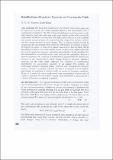JavaScript is disabled for your browser. Some features of this site may not work without it.
| dc.contributor.author | Khan, N. U. M. Akramul Kabir | |
| dc.date.accessioned | 2022-01-04T04:39:20Z | |
| dc.date.available | 2022-01-04T04:39:20Z | |
| dc.date.issued | 2009 | |
| dc.identifier.issn | 2075-650X | |
| dc.identifier.uri | http://digitalarchives.puc.ac.bd:8080/xmlui/handle/123456789/49 | |
| dc.description.abstract | The basic field solutions for electrostatic field in free space can be expressed in terms of a scalar potential function. The electrostatic field is conservative everywhere. The total scalar potential at any arbitrary point, on the other hand, is simply the scalar sum of the contributions produced by each of the independent elemental source points. The differential elements of source charge may consist of several types of contributions that range from volume, surface, and line charge densities to point charges. Thus, a concrete expression can be constructed for electrostatic field when the distribution of charges is known throughout the space. A much more typical case arises when the static charge distribution is known over some limited region of space only. Differential field laws can be applied at all points within the region and thereby the conditions for the mathematical acceptability of the static field can be established. Poisson’s equation expresses the condition of mathematical acceptability for electrostatic potential in the regions where volume charge density is not zero. Laplace’s equation, on the other hand, expresses the condition of mathematical acceptability for electrostatic potential in all charge free regions. An electrostatic problem involving linear, isotropic, and homogeneous dielectric reduces, therefore, to finding solutions of Laplace’s equation in each medium, and joining the solutions in various media by means of boundary conditions. Hence, it is needed for one to understand some mathematical characteristics of Laplace’s equation in order to know exactly what information is necessary for a solution of Poisson’s or Laplace’s equation. | en_US |
| dc.language.iso | en_US | en_US |
| dc.publisher | Premier University, Chattogram | en_US |
| dc.relation.ispartofseries | Premier Critical Perspectives;Vol. I (2009), P.40-60 | |
| dc.title | Ramifications of Laplace's Equation and Electrostatic Fields | en_US |
| dc.type | Article | en_US |
